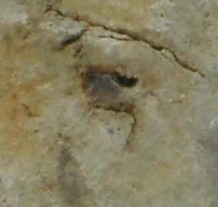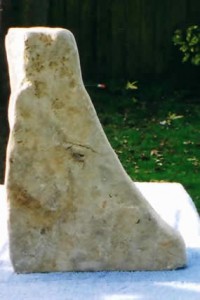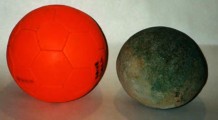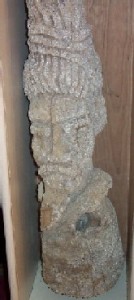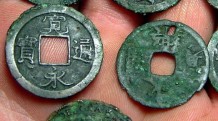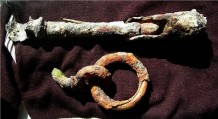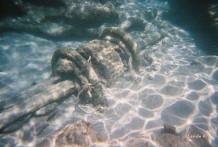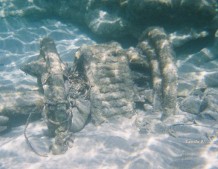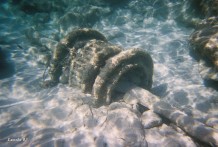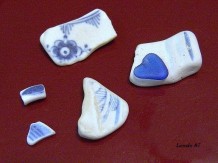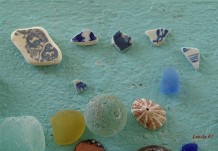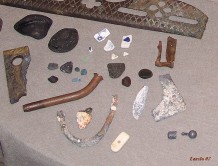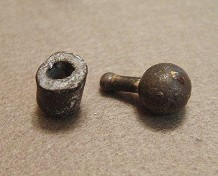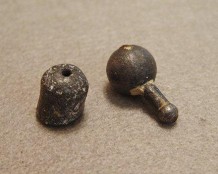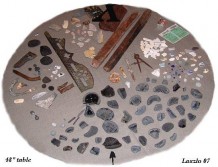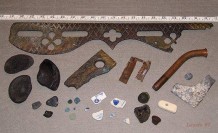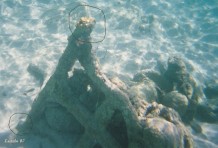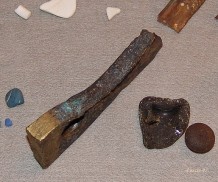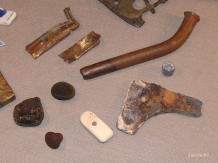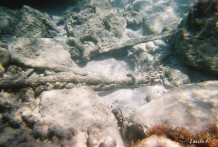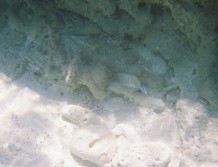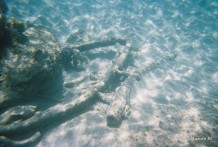Fraser Island ‘cannon’
This photograph, courtesy of Brett J. Green, shows the Fraser Island wreck, that was partially excavated last year. The site is a source of much controversy: the “official” statement is that the wreck is that of the Italian liner “Marloo” that sank during a cyclone back in 1914 and that the “cannons” are the lifeboat davits on the top deck which have somehow come loose from the main frame of the ship. Many don’t believe this statement for some of the following reasons: the “Marloo” is actually located approximately 3 kms north of the Fraser Island site, completely covered in about 30 metres of water – the wreck photographed here is in two metres of beach sand only 100 metres from the shoreline to the south. Also, the “Marloo” was completely steel constructed with wood planking on the decks – this wreck has large curved 30x40cm (12-16inch) wood rib frames with no apparent steel framing.
Any new information on the wreck would be much appreciated.
Moeraki hull ballast
Pictures of junk ballast with lead insert from Moeraki, November 2003.
Cannonball found at Moeraki, November 2003
Wooden Sculpture dated to 1400 A
This artefact was pulled off the ocean floor in the Gulf of Mexico close to Aransas Pass, Texas and has been dated to c1400AD. It is assumed to have come off a shipwreck and the carving appears to be Chinese in style and composition – note the pointed beard and slit eyes. Charles R. Daniel
Curious inscription found with a shipwreck in Mauritius.
A reader, Joe Parish, tells us that when the Dutch arrived in Mauritius, they found remains of a shipwreck and an inscription which they thought to be Arabic. Modern day scholars do not think that it is Arabic but offer no alternative language. Could it have been one of the Indian or south-east Asian languages and the shipwreck the remains of one of the Chinese trading vessels trading in the Indian Ocean? The extract, from the journal of Heyndrick Dircksz Jolinck, a member of the first Dutch expedition to land at Mauritius, reads:
“On 24 [September 1598]I …..going ashore we found a ship”s yard lying on the beach and
[it] was 44 1/2 feet long and in the middle 8 palms thick and at the top 6 palms and [it] was cedar wood, of the sort which grows in the Indies, so that it was obvious that a ship had been wrecked here, because along the beach we found more than 200 pounds of wax on some of which Arabic inscriptions were written as follows: [figure of inscription]” “But it was difficult to read, because it probably had been drifting at sea for a long time and it was badly battered and rubbed” (from Moree, p.10).
Here is a copy of the inscription (from Moree 1998). If you can shed any further light on this matter please contact us.
Miscellaneous finds on Vancouver Island’s west coast
A reader has retrieved several items from along the coastline of Vancouver Island. He would like to know if anyone can shed any light on his finds.
Shipwreck in the Caribbean – Anchor hoist 1
This anchor hoist was photographed recently by a friend of 1421 in the Caribbean. We are pretty sure that the site where these artifacts were salvaged is home to several wrecks. However, we have been told on good authority that one of the wrecks is Chinese and very old. We much look forward to exploring this remarkable site in greater depth in the near future. Please watch this space!
Shipwreck in the Caribbean – Blue and white
Can anyone help us identify these shards of blue and white, found on the seabed in the Caribbean?
Shipwreck in the Caribbean – Lead items
These lead items were found at the Caribbean wreck site.
Shipwreck in the Caribbean – Miscellaneous artefacts
These miscellaneous artefacts, including glass, ceramics and metal objects, were photographed in the Caribbean. The black items have been identified as a type of early glass. Can you help us identify the other items pictured?
Shipwreck in the Caribbean – Windlass
This windlass was photographed at the Caribbean wreck site.
Shipwreck in the Caribbean – Debris Field
This debris field was photographed recently by a friend of 1421 in the Caribbean. The site is home to several wrecks. However, we have been told on good authority that one of the wrecks is Chinese and very old. We much look forward to exploring this remarkable site in greater depth in the near future. Please watch this space!

